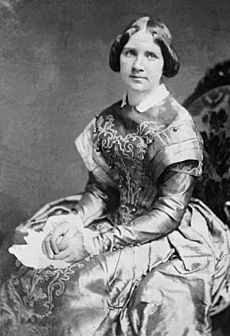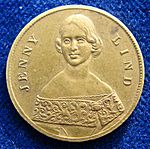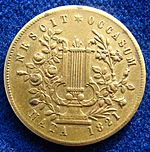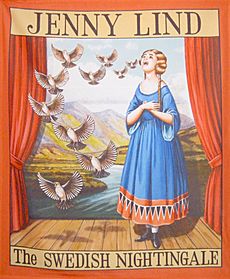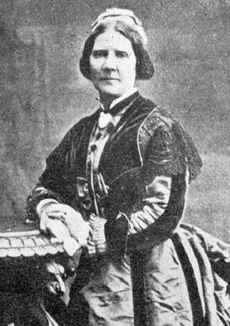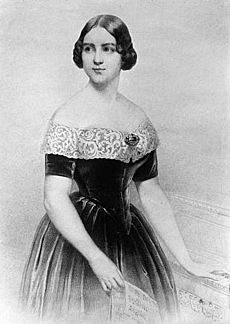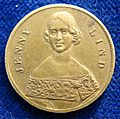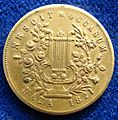Jenny Lind facts for kids
Quick facts for kids
Jenny Lind
|
|
|---|---|
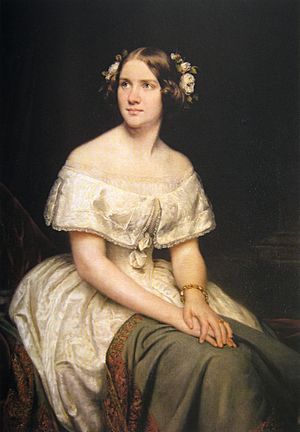
1862 Portrait by Eduard Magnus
|
|
| Born | 6 October 1820 Klara, Stockholm, Sweden
|
| Died | 2 November 1887 (aged 67) Herefordshire, England
|
| Occupation | Operatic soprano |
| Spouse(s) |
Otto Goldschmidt
(m. 1852) |
Johanna Maria "Jenny" Lind (born October 6, 1820 – died November 2, 1887) was a famous Swedish opera singer. People often called her the "Swedish Nightingale" because of her beautiful voice. She was one of the most popular singers in the 1800s.
Jenny Lind sang in operas in Sweden and all over Europe. She also went on a super popular concert tour in the United States starting in 1850. She became a member of the Royal Swedish Academy of Music in 1840.
Lind became very famous after singing in Der Freischütz in Sweden in 1838. A few years later, her voice got hurt from overuse. But a singing teacher named Manuel García helped her save her voice. She was in high demand for opera roles across Europe in the 1840s. She was also good friends with the composer Felix Mendelssohn. After two very successful seasons in London, she decided to stop singing opera when she was 29 years old.
In 1850, Jenny Lind traveled to America. The famous showman P. T. Barnum invited her. She performed in 93 big concerts for him. After that, she continued her tour on her own. She earned more than $350,000 from these concerts. She gave all the money to charities, especially to help start free schools in Sweden. She married Otto Goldschmidt in 1852 and returned to Europe. They had three children and she sang in concerts sometimes for the next 30 years. She settled in England in 1855. From 1882, she was a singing teacher at the Royal College of Music in London for several years.
Contents
The Life of Jenny Lind
Her Early Life and Amazing Voice
Jenny Lind was born in Klara, a part of central Stockholm, Sweden. Her father, Niclas Jonas Lind, was a bookkeeper. Her mother, Anne-Marie Fellborg, was a schoolteacher who ran a day school for girls.
When Jenny was about 9, her singing was heard by a maid. The maid worked for Mademoiselle Lundberg, who was the main dancer at the Royal Swedish Opera. The maid was amazed by Jenny's voice. She brought Lundberg to hear Jenny the next day. Lundberg helped Jenny get into the Royal Dramatic Training Academy, a drama school. There, she studied with Carl Magnus Craelius, the singing teacher at the theater.
Jenny Lind started singing on stage when she was 10. She had a voice problem at age 12 and had to stop singing for a while. But she got better. Her first big role was Agathe in Weber's Der Freischütz in 1838. This was at the Royal Swedish Opera. By age 20, she was a member of the Royal Swedish Academy of Music. She was also a court singer for the King of Sweden and Norway.
Her voice became seriously damaged because she used it too much and didn't have proper training. But her career was saved by the singing teacher Manuel García. She studied with him in Paris from 1841 to 1843. He told her not to sing at all for three months. This allowed her vocal cords to heal. After that, he taught her a healthy and safe way to sing.
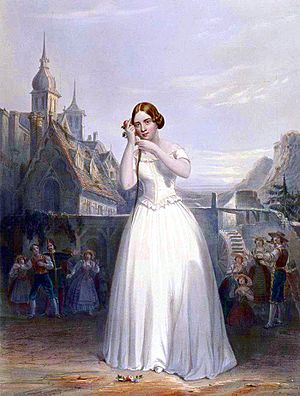
After a year with García, the composer Giacomo Meyerbeer helped Jenny get an audition. He was a big fan of her talent. The audition was at the Opéra in Paris, but she was not accepted. Jenny was very upset by this. Later, when she became a world-famous star, she always said no to invitations to sing at the Paris Opéra.
Jenny Lind returned to the Royal Swedish Opera. She was a much better singer thanks to García's training. She toured Denmark in 1843. There, Hans Christian Andersen met her and fell in love. They became good friends, but she did not feel the same way about him. People believe she inspired three of his fairy tales: "Beneath the Pillar," "The Angel," and "The Nightingale." Andersen wrote that no one had a greater positive influence on him as a writer than Jenny Lind.
Becoming Famous in Germany and Britain
In December 1844, Meyerbeer helped Jenny Lind get a role in Berlin. She sang the main part in Bellini's opera Norma. This led to more singing jobs in opera houses across Germany and Austria. She was so successful in Berlin that she stayed there for four months. Among her early fans were Robert Schumann, Hector Berlioz, and most importantly, Felix Mendelssohn.
Ignaz Moscheles wrote that Jenny Lind "fairly enchanted" him. He said her song with two flutes was "perhaps the most incredible feat in the way of bravura singing." This song was from Meyerbeer's Ein Feldlager in Schlesien (The Camp of Silesia). It became one of Jenny Lind's most famous songs. She was asked to sing it everywhere she performed.
Her opera roles included the main parts in Lucia di Lammermoor, Maria di Rohan, Norma, La sonnambula, and La vestale. She also sang as Susanna in The Marriage of Figaro, Adina in L'elisir d'amore, and Alice in Robert le diable. Around this time, she became known as "the Swedish Nightingale."
In December 1845, she sang for free at a charity concert. This was the day after her first performance at the Leipzig Gewandhaus with Mendelssohn. Her dedication to helping others was a big part of her career. It made her even more popular around the world.
Jenny Lind was friends with the tenor Julius Günther at the Royal Swedish Opera. They sang together and started a romantic relationship by 1844. Their busy schedules kept them apart. Günther stayed in Stockholm and then studied with Garcia in Paris. They got engaged in spring 1848, but they broke it off in October of the same year.
After a successful time in Vienna, Jenny Lind went to London. She gave her first performance there on May 4, 1847. She appeared in an Italian version of Meyerbeer's Robert le diable. Queen Victoria attended all sixteen of Lind's first performances in London. In July 1847, Lind starred in the first-ever performance of Verdi's opera I masnadieri. Verdi himself conducted the show.
During her two years singing opera in London, Lind performed in many well-known operas. In early 1849, while still in her twenties, Lind announced she was stopping opera for good. Her last opera performance was on May 10, 1849, in Robert le diable. Queen Victoria and other members of the Royal Family were there. No one knows for sure why she retired from opera so early.
Jenny Lind and Felix Mendelssohn
In London, Jenny Lind's close friendship with Mendelssohn continued. Mendelssohn was at Lind's London debut in Robert le diable. His friend, the critic Henry Chorley, wrote that Mendelssohn was very happy. He loved Lind's talent and wanted her to succeed.
Mendelssohn worked with Lind many times. He started writing an opera called Lorelei for her. It was based on the legend of the Lorelei Rhine maidens. But he died before he could finish it. He also wrote the soprano part in his oratorio Elijah ("Hear Ye Israel") with Lind's voice in mind. He focused on a specific high note (F-sharp) that he found very charming in her voice.
Four months after her London debut, Jenny Lind was very sad when Mendelssohn died too soon in November 1847. At first, she felt she couldn't sing the soprano part in Elijah, which he had written for her. But she finally did in a performance in London in late 1848. This concert raised £1,000 to create a music scholarship in his memory. It was her first time singing in an oratorio.
The scholarship was meant to help music students from all over the world. With help from Sir George Smart, Julius Benedict, and others, Lind raised enough money. The first person to receive the Mendelssohn Scholarship was 14-year-old Arthur Sullivan. Lind encouraged him in his music career.
Her American Tour
In 1849, the American showman P. T. Barnum asked Jenny Lind to tour the United States for over a year. Jenny realized this tour could raise a lot of money for charity. She especially wanted to help start free schools in her home country, Sweden. So, she agreed. Her financial demands were high, but Barnum met them. They made an agreement in 1850.
Jenny Lind sailed to America in September 1850. She traveled with a baritone singer, Giovanni Belletti, and her London friend, Julius Benedict. Benedict was her pianist, arranger, and conductor. Barnum's advertising made her a celebrity even before she arrived in the US. She received a huge welcome when she got to New York. Tickets for some of her concerts were so popular that Barnum sold them by auction. People were so excited that the American newspapers called it "Lind mania."
After her first two shows in New York in September 1850, Jenny Lind's group toured the East Coast of America. They had continued success. Later, they visited Cuba, the Southern US, and Canada. By early 1851, Lind felt uncomfortable with Barnum's constant advertising. She used a part of her contract to end her agreement with him. They separated in a friendly way.
She continued the tour for almost another year on her own. This lasted until May 1852. Benedict left the group in 1851 to go back to England. Lind then asked Otto Goldschmidt to be her new pianist and conductor. Lind and Goldschmidt got married on February 5, 1852, near the end of the tour, in Boston. She started using the name "Jenny Lind-Goldschmidt" for both her private and professional life.
We don't have many details about the concerts she managed herself. But we know that under Barnum's management, Lind gave 93 concerts in America. She earned about $350,000 from these. Barnum made at least $500,000. She gave her earnings to different charities. These included free schools in Sweden and some US charities.
The tour is part of the story in the 1980 musical Barnum and the 2017 film The Greatest Showman. Both of these include a made-up romantic story between Lind and Barnum.
Her Later Years
Jenny Lind and Otto Goldschmidt returned to Europe in May 1852. They first lived in Dresden, Germany. From 1855, they lived in England for the rest of their lives. They had three children: Otto, born in September 1853 in Germany; Jenny, born in March 1857 in England; and Ernest, born in January 1861 in England.
Even though she refused to sing in opera after returning to Europe, Lind continued to perform in concerts. In 1856, she sang the main soprano part in the first English performance of the cantata Paradise and the Peri. This was by Robert Schumann. In 1866, she gave a concert with Arthur Sullivan. The Times newspaper reported that her voice still had "magic" and was "the most perfect singing."
In January 1870, she sang in Ruth, an oratorio composed by her husband. When Goldschmidt started the Bach Choir in 1875, Lind trained the soprano singers. This was for the first English performance of Bach's B minor Mass in April 1876. She also performed in the mass. Her concerts became less frequent until she stopped singing in 1883.
From 1879 to 1887, Lind worked with Frederick Niecks on his book about Frédéric Chopin. In 1882, she became a professor of singing at the new Royal College of Music. She believed her students should have a complete music education. She insisted they learn singing, solfège (music reading), piano, harmony, clear speaking, stage presence, and at least one foreign language.
She spent her final years at Wynd's Point, Herefordshire, near the Malvern Hills. Her last public performance was at a charity concert in 1883. She died at age 67 on November 2, 1887. She was buried in the Great Malvern Cemetery with Chopin's Funeral March playing. She left a lot of her money to help poor Protestant students in Sweden get an education.
How People Remember Jenny Lind
There are no known recordings of Jenny Lind's voice. She might have made an early recording for Thomas Edison. But even if it still existed, it would be too old to tell us much about her voice.
Some critics believed that while Lind was admired by many famous composers, her voice and acting were not as good as some other singers of her time. They noted that her promoters, like Barnum, created a lot of positive buzz about her. Some American critics felt her singing was more "cold, untouching, icy purity" rather than the strong emotion needed for Italian opera. They thought her style was better for people in "cold climates" like America.
The critic H. F. Chorley admired Lind. He said her voice had a range of two octaves. He noted that the lower part of her voice was not as strong, but the upper part was "rich, brilliant and powerful." Chorley praised how she controlled her breath and used soft singing. He also liked her good taste in adding musical decorations and how she used her skills to hide differences in her voice. He thought her singing was "great" and that she was a "skilled and careful musician."
Chorley felt her concert singing was better than her opera performances. But he did praise some of her opera roles. He thought her best work was in German music, like Mozart, Haydn, and Mendelssohn's Elijah. Many people believed her wide appeal was not just because of Barnum's marketing. It was also because her voice had a "uniquely pure" quality. This matched her well-known kindness and charity.
Memorials and Tributes
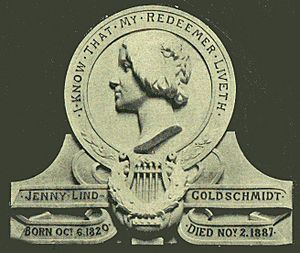
Jenny Lind is remembered in Poets' Corner at Westminster Abbey in London. Her memorial is under the name "Jenny Lind-Goldschmidt." Many important people were at the unveiling ceremony in 1894. These included her husband, members of the Royal Family, Arthur Sullivan, and representatives from charities she supported.
There is also a plaque for Lind in The Boltons, Kensington, London. A blue plaque was put up in 1909 at 189 Old Brompton Road, London.
Jenny Lind has been honored in music, movies, and even on money. Both the 1996 and 2006 Swedish 50-krona banknotes show a picture of Lind on the front. Many artworks have featured her. Anton Wallerstein composed the "Jenny Lind Polka" around 1850.
In the 1930 Hollywood film A Lady's Morals, Grace Moore played Lind. In 1941, Ilse Werner starred as Lind in the German movie The Swedish Nightingale. In 2001, a movie called Hans Christian Andersen: My Life as a Fairytale showed Flora Montgomery as Lind. In 2005, Elvis Costello said he was writing an opera about Lind. A 2010 BBC TV show about Chopin talked about how Lind "affected" the composer.
Many places and things are named after Jenny Lind. These include Jenny Lind Island in Canada. There was also a train called the Jenny Lind and a fast sailing ship called the USS Nightingale. An Australian schooner (a type of boat) was also named Jenny Lind. In 1857, it crashed in a creek in Queensland, Australia. So, the creek was named Jenny Lind Creek. A bronze statue of Jenny Lind sits in Stockholm, Sweden. It was put there in 1924.
In Britain, her husband started a children's hospital in her honor in Norwich. Today, it is called the Jenny Lind Children's Hospital. There is also a Jenny Lind Park in Norwich. A chapel at the University of Worcester is named for Lind. A hotel and pub in Hastings, England, is named after her. Hereford County Hospital has a psychiatric ward named for Jenny Lind. A part of Glasgow, Scotland, is named after her. In Sutton, London, a pub called "The Jenny Lind" was renamed "The Nightingale."
In the US, Jenny Lind is remembered with street names in many towns. These include Amelia, Ohio; Fort Smith, Arkansas; New Bedford, Massachusetts; and Taunton, Massachusetts. The town of Jenny Lind, California is likely named after her. An elementary school in Minneapolis, Minnesota, is named for her. The Jenny Lind Tower, a stone tower in North Truro, Massachusetts, is also named after her.
She visited Mammoth Cave in Kentucky in 1851. A spot in the cave was named "Jenny Lind's Armchair" in her honor. Cottage-style furniture, especially cribs and beds, are still called Jenny Lind. Andover, Illinois, has the Jenny Lind Chapel. This Swedish Lutheran Chapel received $1,500 from Lind to help build it. The Jenny Lind Wing is part of a student building at Augustana College in Rock Island, Illinois. The college also has a Jenny Lind Vocal Ensemble. Jenny Lind soup is a soup named for her. The American Swedish Historical Museum has a Jenny Lind Room. It is dedicated to her and how popular she was in America.
Norwegian Air Shuttle has a Boeing 737-8JP airplane named Jenny Lind. It has a drawing of Lind on its tail.
See also
 In Spanish: Jenny Lind para niños
In Spanish: Jenny Lind para niños
- Jenny Lind private railroad car
- Justina Casagli
- Elisabeth Frösslind
- Elisabeth Olin
- Lina Sandell
- List of Swedes in music
Images for kids


